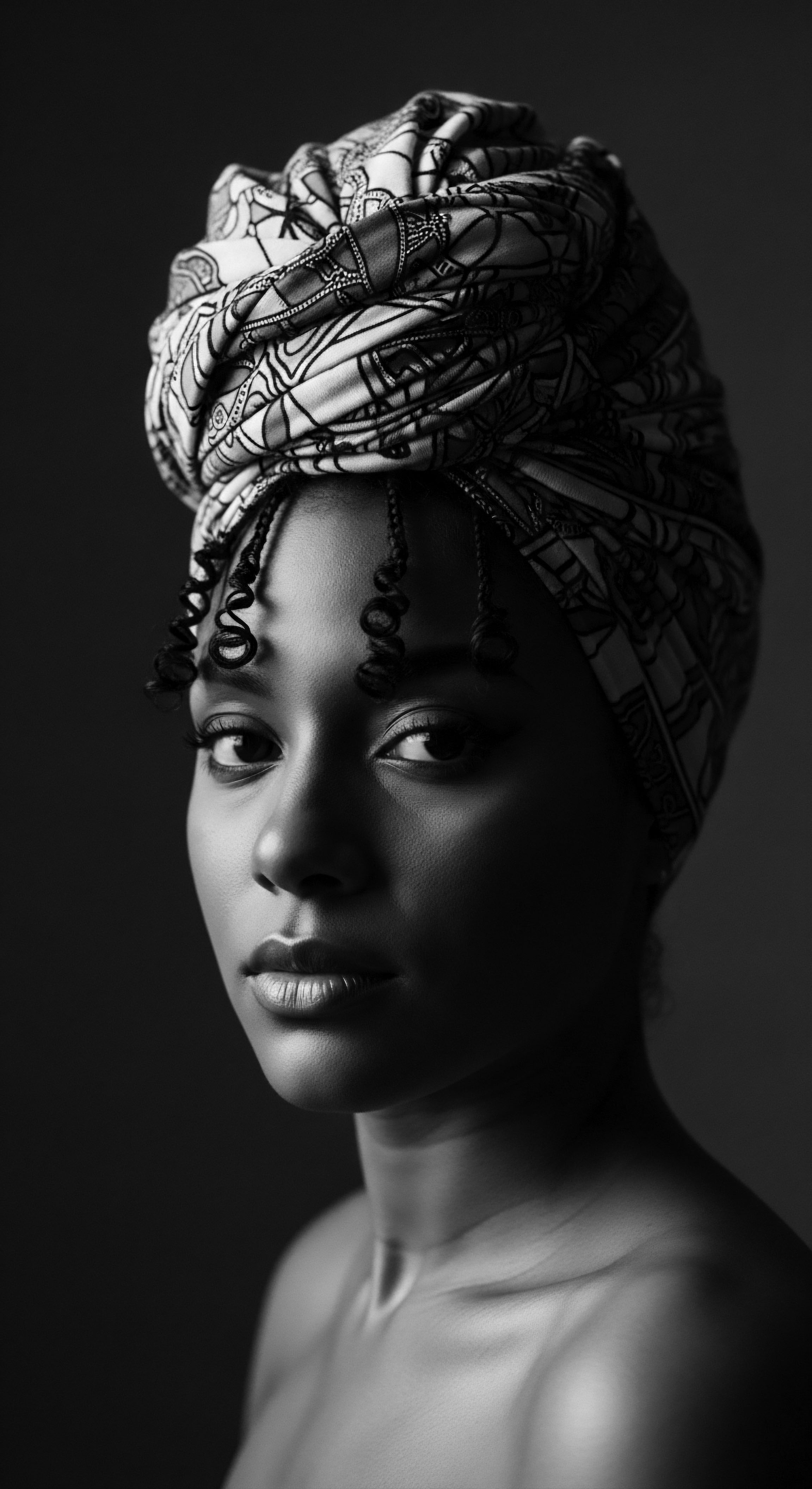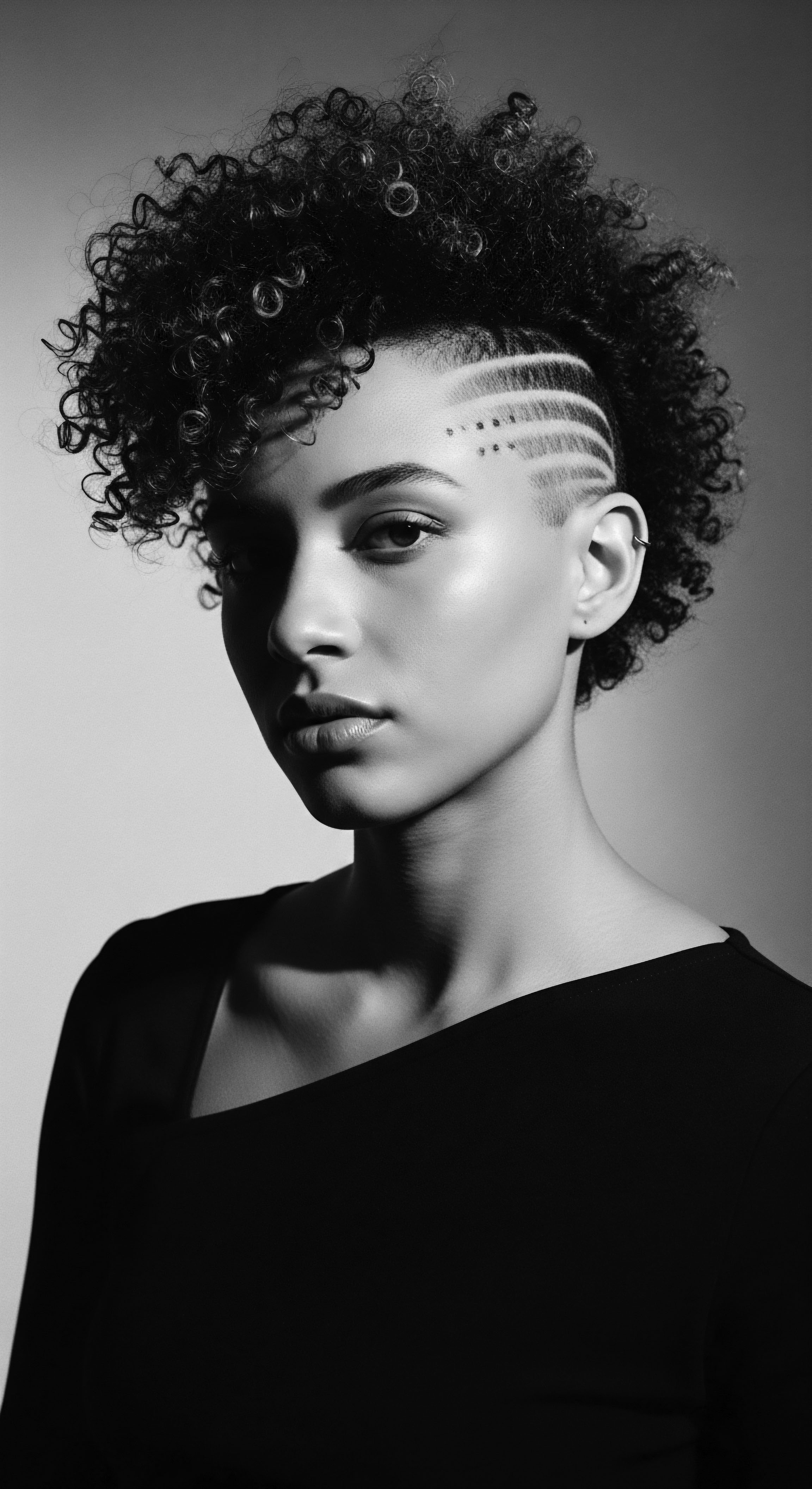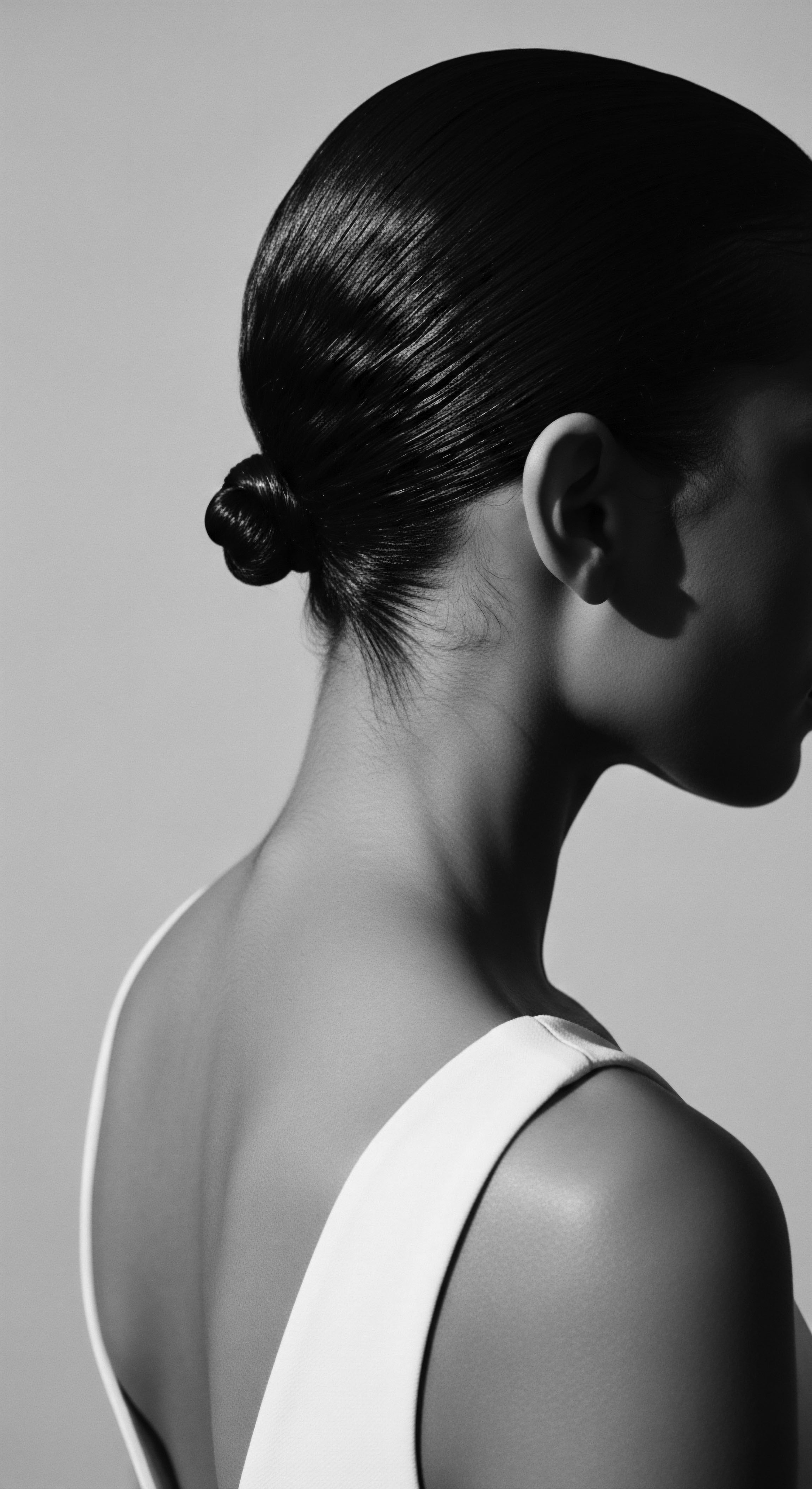
Roots
Consider, for a moment, the crown that sits upon your head, not as a fleeting style, but as a living legacy. For those with textured hair, this understanding is etched into the very helix of each strand, a story passed down through generations. Our hair, with its unique coils and curves, is a testament to ancient ingenuity and a profound connection to the earth, to community, and to self. To truly grasp what traditional fabrics shield textured hair, we must first honor the very structure of this hair, recognizing its inherent grace and its historical needs.
The biology of textured hair, often characterized by its intricate spirals and tight curls, renders it distinct from straight hair. Each curve in the strand creates points of vulnerability, places where the cuticle lifts, making it more susceptible to moisture loss and friction. This inherent characteristic, understood through observation over millennia, shaped ancestral care practices.
Early communities, long before modern scientific inquiry, intuitively recognized this delicate balance, developing rituals and choosing materials that offered solace and protection. This wisdom forms the bedrock of our present understanding.

Hair’s Delicate Blueprint and Ancestral Wisdom
From the desert sands to the humid forests, our ancestors observed their hair’s responses to environment. They saw how the elements could strip vitality, how daily interactions could lead to wear. This deep observation, generations of hands-on experience, became a repository of knowledge.
The materials chosen to cloak hair were not accidental; they were selected for their ability to guard against this natural fragility. They sought substances that offered a smooth embrace, a gentle barrier that would not contend with the hair’s own inclinations.
Hair, in many traditional African societies, held spiritual weight. It was seen as a conduit to the divine, a marker of identity, and a symbol of wisdom. Protecting it, therefore, carried a significance beyond mere aesthetics. It was a ritual of reverence.
The chosen fabrics became an extension of this sacred trust, acting as guardians of both physical health and cultural integrity. This holistic perspective, where hair is connected to spirit and community, guides our understanding of why certain traditional fabrics ascended to prominence in hair care.
Traditional hair care, deeply rooted in ancestral observation, recognized the inherent fragility of textured hair and sought protection through natural, gentle fabrics.

The Early Protectors of Hair’s Heritage
While the opulent silks we now associate with hair preservation may have been reserved for royalty or special occasions in ancient times, simpler, locally accessible fibers often served as the first line of defense. Consider the supple feel of finely woven cotton or linen that, when processed with care, could offer a smoother surface than harsher, unprocessed alternatives. These were the daily shields. Over time, as trade routes expanded and craftsmanship evolved, more refined options became available, each serving a similar, yet increasingly sophisticated, purpose.
Understanding the historical continuum of hair care means appreciating these humble beginnings. It prompts us to consider the ingenious ways diverse peoples, separated by geography, arrived at similar solutions for hair preservation, often through trial and error, guided by shared needs. The common thread in these traditions points to an intuitive grasp of how friction, moisture, and environment interact with the hair’s surface.

Ritual
The styling of textured hair has always been an art form, a language spoken through coils and braids, a declaration of identity and spirit. Within this rich tradition, the role of protective styling is paramount. These methods, designed to shield the hair from daily environmental aggressors and manipulation, are inextricably linked to the choice of fabrics. They are not merely fashion statements; they are acts of preservation, practices honed over centuries, often intertwined with the practical application of specific textiles.

How Did Traditional Fabrics Secure Hair’s Style?
Consider the long, elaborate processes involved in creating many traditional textured hair styles, such as intricate cornrows, braided patterns, or twisted styles. These are not styles meant for a single day. Their longevity was, in part, secured by the use of head coverings crafted from materials that would not disturb the hair’s carefully arranged structure.
A coarse fabric could snag a strand, unravel a braid, or leach precious moisture. Smooth, forgiving materials became allies in maintaining these complex arrangements, allowing them to last for weeks or even months, a testament to the skill of the stylist and the wisdom of the care ritual.
One powerful historical example, deeply resonating with Black and mixed-race experiences, is the phenomenon of the Tignon Laws in 18th-century Louisiana. Enacted in 1786, these laws compelled free Black women to cover their hair with tignons or headwraps, an attempt by colonial authorities to denote their perceived lower social status and distinguish them from white women. Yet, these women, with remarkable resilience and spirit, transformed these mandated coverings into expressions of elaborate beauty and defiance.
They sourced fine materials, including silks and satins, adorning their headwraps with jewels and intricate ties, converting a symbol of oppression into an act of self-assertion and elegance (Ari Party Hair, 2025). This practice not only preserved their elaborate hairstyles beneath but also cemented the headwrap as a powerful emblem of identity and resistance.
The Tignon Laws illustrate how forced hair coverings transformed into expressions of defiant beauty and identity through the choice of fine fabrics.

Ancient Textiles in Styling Practices
Across various African societies, the headwrap, known by names like Gele in Nigeria or Doek in South Africa, served as a functional and symbolic accessory. These wraps, crafted from a variety of textiles, including cotton and, for the elite, imported silks, were not just for adornment. They provided a layer of protection, preventing the environmental assault of sun, wind, and dust from damaging delicate hairstyles. They also served to maintain the neatness of intricate styles, a practical necessity in daily life and for ceremonial occasions.
The types of traditional fabrics employed for hair preservation were selected for specific qualities ❉
- Silk ❉ Revered for its smooth fibers, silk offers minimal friction, reducing tangles and breakage. Historically, it was a luxury item, traded and reserved for significant occasions or high social standing, as seen in West African cultures where silk was imported for elaborate headwraps.
- Satin ❉ While often a modern synthetic blend, satin’s smooth surface mimics silk’s protective qualities, making it a popular and accessible choice in contemporary applications, continuing the heritage of gentle hair covering.
- Fine Cotton ❉ Softer, tightly woven cottons, particularly those with a sateen finish, offered a more breathable, less abrasive alternative to coarse cottons, providing a degree of protection for daily wear.
The transition from day to night also saw these fabrics play a central part. After hours of intricate styling, or simply to preserve the hair’s natural state, covering the hair with a protective fabric before rest was a common, intuitive practice. This nightly ritual prevented styles from being disturbed by movement against rough sleeping surfaces, thereby extending the life of the style and reducing the need for constant manipulation.
| Cultural Origin West Africa (Yoruba, Igbo) |
| Traditional Covering Name Gele |
| Typical Fabric Type Cotton, Imported Silk |
| Hair Preservation Function Maintained elaborate styles, offered environmental protection, displayed status. |
| Cultural Origin Southern Africa (Zulu, Xhosa) |
| Traditional Covering Name Doek |
| Typical Fabric Type Cotton, Linen |
| Hair Preservation Function Protected hair from dust and sun during daily chores, indicated marital status. |
| Cultural Origin African American Diaspora (Louisiana) |
| Traditional Covering Name Tignon |
| Typical Fabric Type Fine Silks, Cottons |
| Hair Preservation Function Preserved intricate coiffures, transformed a sign of oppression into an act of stylish resistance. |
| Cultural Origin These examples illustrate a consistent historical understanding that specific fabrics provided a gentle shield for textured hair, reinforcing cultural identity. |

Relay
The care of textured hair extends beyond momentary styling; it is a continuous dialogue between the hair and its environment, a conversation deeply informed by ancestral wisdom. Within this ongoing regimen, the choice of fabric for nighttime protection stands as a cornerstone practice, a quiet ritual carried out in the stillness of the evening. This conscious selection of materials is not a modern innovation but a continuation of long-standing practices, adapting ancient knowledge to contemporary needs while upholding the spirit of holistic care.

Does Fabric Choice Impact Hair Health During Rest?
The answer is an unequivocal yes, and our ancestors understood this implicitly. When textured hair rests against a rough surface, like a common cotton pillowcase, the delicate outer layer, the cuticle, is subjected to friction. This constant rubbing can lift the cuticles, leading to snagging, breakage, and the accelerated loss of essential moisture.
Over time, this leads to dryness, frizz, and a diminished vitality. Traditional fabrics, particularly those with smooth surfaces, provided a buffer against this nightly wear, acting as silent guardians of hair health.
The wisdom of covering hair at night stems from a dual objective ❉ preserving the integrity of intricate styles and maintaining the hair’s hydration. A wrapped head, using specific materials, creates a micro-environment that minimizes friction and helps to keep the hair’s natural moisture, or any applied oils and conditioners, contained within the strand. This practice is a direct lineage from ancestral wellness philosophies, where every aspect of self-care was viewed holistically, with an eye towards both immediate benefit and long-term health.

The Nighttime Sanctuary and Fabric Guardians
While the modern market offers a variety of sleep accessories, their underlying principles often echo historical traditions. The widespread adoption of silk and satin bonnets and pillowcases, for instance, reflects a re-discovery of truths understood centuries ago. These materials provide a smooth surface that allows hair to glide without snagging, significantly reducing breakage. Furthermore, unlike absorbent cotton, silk and satin do not wick moisture from the hair, helping to maintain its natural hydration and the effectiveness of any conditioning treatments applied before bed.
Consider the historical use of hair coverings not just for styling, but for deep treatment. Imagine a time when natural ingredients—herbs, oils, and butters—were applied to the hair to nourish and condition. A protective fabric wrap would have been essential to keep these treatments contained, allowing them to penetrate without being absorbed by bedding or smeared across sleeping surfaces. This practical application reinforces the interconnectedness of chosen fabrics and the efficacy of ancestral hair rituals.
Nighttime hair protection with smooth fabrics is a time-honored practice, preventing moisture loss and friction to safeguard hair’s vitality.

Solving Hair Challenges with Fabric Knowledge
Many common challenges faced by those with textured hair today—dryness, breakage, and frizz—are issues that ancestral practices sought to mitigate. The traditional understanding that certain fabrics exacerbated these problems, while others alleviated them, formed a practical compendium of solutions.
For example, the coarser weaves of unprocessed cotton or wool, while readily available, were likely observed to cause tangles and dryness over extended contact. This observational data, passed down orally and through lived example, would have guided communities toward more refined, smoother options when such choices were available, or towards specific wrapping techniques to minimize direct contact with abrasive surfaces.
The enduring legacy of these practices is evident in the continued relevance of smooth, non-absorbent fabrics for textured hair. This knowledge is not static; it is a living archive, continuously informing new generations how to honor their hair’s unique structure through thoughtful care, a direct relay of wisdom from past to present.
| Fabric Type Silk (e.g. Charmeuse, Mulberry) |
| Historical Accessibility Luxury, limited to elite or specific trade routes. |
| Impact on Hair Moisture Retains hair moisture due to low absorbency. |
| Friction Level Very low, allows hair to glide. |
| Fabric Type Satin (modern often polyester/acetate) |
| Historical Accessibility Post-industrial revolution, mass-produced. |
| Impact on Hair Moisture Similar to silk, helps retain moisture. |
| Friction Level Low, smooth surface reduces snags. |
| Fabric Type Fine Weave Cotton (e.g. Sateen) |
| Historical Accessibility More accessible than silk, widely available. |
| Impact on Hair Moisture Moderately absorbent, less so than coarse cotton. |
| Friction Level Moderate, better than coarse cotton, but more than silk/satin. |
| Fabric Type Coarse Cotton/Linen (traditional raw) |
| Historical Accessibility Highly accessible, basic textile. |
| Impact on Hair Moisture Highly absorbent, can dry hair. |
| Friction Level High, prone to snagging and breakage. |
| Fabric Type Understanding these fabric properties reveals a continuity in ancestral practices aimed at preserving hair health. |

Reflection
The exploration of what traditional fabrics preserve textured hair leads us on a path far deeper than mere material science. It guides us through the echoes of ancient wisdom, across continents where hair was not just fiber but spirit, status, and story. From the intuitive recognition of hair’s delicate structure to the purposeful selection of smooth, protective textiles, the journey reveals an unbroken chain of care, a continuous conversation between our textured crowns and the hands that tended them through history.
These fabrics are not simply inert objects; they are silent witnesses to resilience, creativity, and the enduring human spirit. They speak of ancestral practices that, though perhaps lacking the vocabulary of modern trichology, arrived at solutions remarkably aligned with scientific understanding. They speak of communities transforming hardship into artistry, as seen in the tignon, a symbol of defiance and beauty born from constraint. The threads of silk, the smooth embrace of satin, or the careful weave of fine cotton are tangible connections to those who came before us, guardians of a heritage that continues to shape our present and light our way forward.
The ‘Soul of a Strand’ ethos reminds us that every hair journey is a living archive, a narrative of self and collective memory. Choosing traditional fabrics for our textured hair is a purposeful act, an affirmation of this deep lineage. It is a way of honoring the wisdom passed down, of recognizing the ingenuity that allowed generations to care for their unique hair in challenging circumstances. This conscious engagement with our hair’s heritage, informed by both ancestral practice and contemporary understanding, permits us to continue writing our own stories of hair preservation, allowing our textured strands to stand unbound, radiant, and deeply connected to their glorious past.

References
- Ari Party Hair. (2025). The History and Symbolism of Hair Wrapping Across the African Diaspora.
- Afrostreet. (2025). The Cultural Significance of Headwraps & How to Wear Them ❉ Embracing Heritage and Style.
- JD Institute of Fashion Technology. (2021). HEADWRAPS ❉ HISTORY AND EVOLUTION.
- Leone Culture. (2023). Exploring the Significance Of Headwraps In African Fashion And Traditions.
- Esme Luxury. (2024). Silk Hair Wraps in Different Cultures ❉ A Global Perspective.
- Sonson. (2021). The History of Headwraps and Black Culture.
- BSB Media. (Unpublished). Black Beauty Heritage ❉ History of Headwraps and How to Style Them Today.
- Wilderness. (2015). The history & meaning of head wraps across Africa.
- That Wasn’t In My Textbook. (2022). The History of Headwraps Unwrapped.
